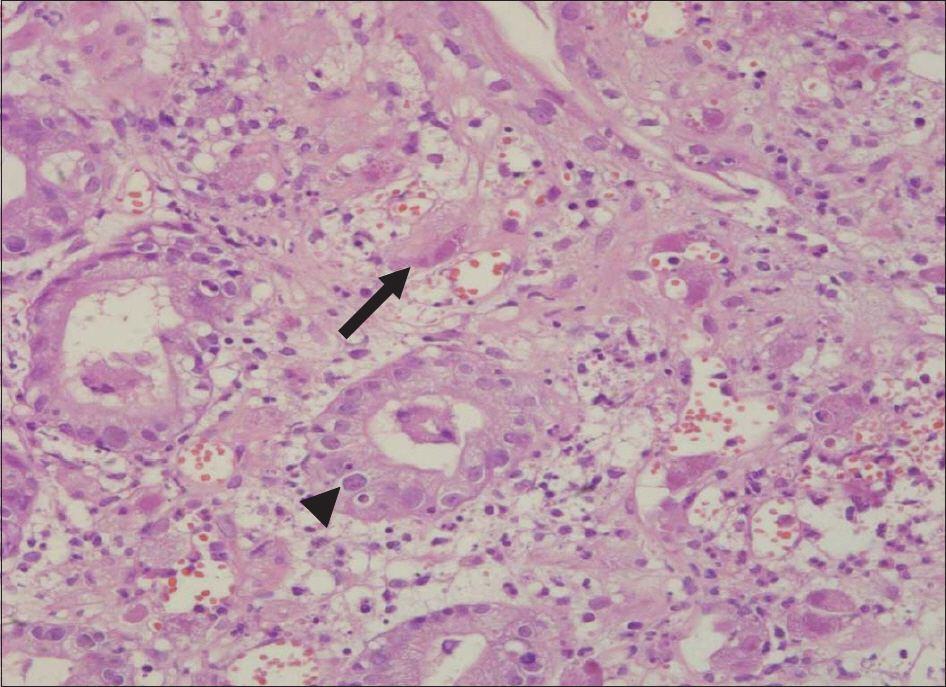J Rheum Dis.
2013 Jun;20(3):172-176. 10.4078/jrd.2013.20.3.172.
Multiple Gastric Ulcers as a Manifestation of Cytomegalovirus Infection in a Patient with Adult-onset Still's Disease
- Affiliations
-
- 1Department of Internal Medicine, Konyang University Hospital, Daejeon, Korea. cij1221@kyuh.ac.kr
- KMID: 2222756
- DOI: http://doi.org/10.4078/jrd.2013.20.3.172
Abstract
- Cytomegalovirus (CMV) is a relatively common viral pathogen, and CMV infection is generally assumed asymptomatic in general hosts. In immunologically compromised patients, CMV infection can cause further serious diseases such as pneumonitis, retinitis, encephalitis, and enterocolitis. A 40-year-old man is being presented with acute fever, myalgia, and sore throat. Laboratory findings have revealed elevated ESR, CRP, and ferritin levels. The patient was being treated for adult-onset Still's disease (AOSD). Three weeks later, although AOSD activity was under control, the patient began to complain about oral soreness, epigastric pain, and diarrhea. Endoscopy revealed multiple round ulcers with white patches in the esophagus and the stomach, sparing the colon. Anti-fungal agent is being administered but failed to bring improvements after 2 weeks of therapy. CMV infection is confirmed with pathology, antiviral agents were initiated after the ulcers subsided. Currently, clinical associations between CMV infection and AOSD are suggested. CMV infection may be considered as a differential diagnosis when multiple upper gastrointestinal ulcerative lesions develop within patients whom have been treated AOSD with immunosuppressive agents.
Keyword
MeSH Terms
-
Antiviral Agents
Colon
Cytomegalovirus
Cytomegalovirus Infections
Diagnosis, Differential
Diarrhea
Encephalitis
Endoscopy
Enterocolitis
Esophagus
Ferritins
Fever
Humans
Immunosuppressive Agents
Pharyngitis
Pneumonia
Retinitis
Still's Disease, Adult-Onset
Stomach
Stomach Ulcer
Ulcer
Antiviral Agents
Ferritins
Immunosuppressive Agents
Figure
Reference
-
References
1. Himoto T, Goda F, Okuyama H, Kono T, Yamagami A, Inukai M, et al. Cytomegalovirus-associated acute gastric mucosal lesion in an immunocompetent host. Intern Med. 2009; 48:1521–4.
Article2. Ishiguro T, Takayanagi N, Kawabata Y, Sugita Y. Intestinal perforation due to concomitant cytomegalovirus infection during treatment for Pneumocystis jirovecii pneumonia in a patient with rheumatoid arthritis. Intern Med. 2011; 50:1835–7.
Article3. Canbakan B, Mizrak D, Keven K, Kaygusuz G, Kutlay S, Sengul S, et al. Gastric ulcer despite no acid in a renal allograft recipient: what is the link? Nephrol Dial Transplant. 2005; 20:2279–81.
Article4. Ju JH, Park HS, Shin MJ, Yang CW, Kim YS, Choi YJ, et al. Successful treatment of massive lower gastrointestinal bleeding caused by mixed infection of cytomegalovirus and mucormycosis in a renal transplant recipient. Am J Nephrol. 2001; 21:232–6.
Article5. Péter A, Telkes G, Varga M, Sá rváry E, Kovalszky I. Endoscopic diagnosis of cytomegalovirus infection of upper gastrointestinal tract in solid organ transplant recipi-ents: Hungarian single-center experience. Clin Transplant. 2004; 18:580–4.
Article6. Wilcox CM, Chalasani N, Lazenby A, Schwartz DA. Cytomegalovirus colitis in acquired immunodeficiency syndrome: a clinical and endoscopic study. Gastrointest Endosc. 1998; 48:39–43.
Article7. Hirsch MS. Cytomegalovirus and Human Herpesvirus Types 6, 7, and 8. 18th ed.p. 1471–5. McGraw Hill;2012.8. Lin WR, Su MY, Hsu CM, Ho YP, Ngan KW, Chiu CT, et al. Clinical and endoscopic features for alimentary tract cytomegalovirus disease: report of 20 cases with gastrointestinal cytomegalovirus disease. Chang Gung Med J. 2005; 28:476–84.9. Patra S, Samal SC, Chacko A, Mathan VI, Mathan MM. Cytomegalovirus infection of the human gastrointestinal tract. J Gastroenterol Hepatol. 1999; 14:973–6.
Article10. Bento DP, Tavares R, Baptista Leite R, Miranda A, Ramos S, Ventura F, et al. Adult-Onset Still's Disease and cytomegalovirus infection. Acta Reumatol Port. 2010; 35:259–63.11. Chacko B, John GT. Leflunomide for cytomegalovirus: bench to bedside. Transpl Infect Dis. 2012; 14:111–20.
Article12. Alanazi AH, Aldekhail WM, Jewell L, Huynh HQ. Multiple large gastric ulcers as a manifestation of cytomegalovirus infection in a healthy child. J Pediatr Gastroenterol Nutr. 2009; 49:364–7.
Article13. Yoda Y, Hanaoka R, Ide H, Isozaki T, Matsunawa M, Yajima N, et al. Clinical evaluation of patients with inflammatory connective tissue diseases complicated by cytomegalovirus antigenemia. Mod Rheumatol. 2006; 16:137–42.
Article14. Efthimiou P, Paik PK, Bielory L. Diagnosis and management of adult onset Still's disease. Ann Rheum Dis. 2006; 65:564–72.
Article15. Amenomori M, Migita K, Miyashita T, Yoshida S, Ito M, Eguchi K, et al. Cytomegalovirus-associated hemophago-cytic syndrome in a patient with adult onset Still's disease. Clin Exp Rheumatol. 2005; 23:100–2.16. Kim DH, Na YS, Lee HJ, Kim YS, Kim HS. A case of cytomegalovirus infection presenting as pericarditis and lupus nephritis flare-up. J Rheum Dis. 2011; 18:224–8.
Article17. Takizawa Y, Inokuma S, Tanaka Y, Saito K, Atsumi T, Hirakata M, et al. Clinical characteristics of cytomegalovirus infection in rheumatic diseases: multicentre survey in a large patient population. Rheumatology (Oxford). 2008; 47:1373–8.
Article
- Full Text Links
- Actions
-
Cited
- CITED
-
- Close
- Share
- Similar articles
-
- Cytomegalovirus Induced Gastric Ulcer as a Principal Manifestation in the Initial Stage of Hodgkin's Disease
- Gastric Ulcers with Cytomegalovirus Infection in an Immunocompetent Patient
- Cytomegalovirus Infectious Mononucleosis in a Patient with a Gastric Ulcer
- Two Cases of Cutaneous Cytomegalovirus Infection in Immunocompromised Patients
- A Case of Cytomegalovirus-Associated Esophageal and Duodenal Ulcers in a Critically Ill Immunocompetent Patient




